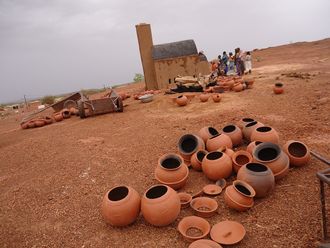Gisharu (Kenya): On the edge of Mt. Suswa, an active volcano in southwest Kenya’s Rift Valley, Kipas Ole Masiodo checks on volcanic steam rising from cracks in the ground, careful not to let any go to waste.
As prolonged drought dries water reserves across Kenya, harvesting these fleeting wisps of water vapour near Masiodo’s home has been a lifeline for his family and community.
“It is clean and safe for drinking,” the 35-year-old said.
“It is not much, but it is better than travelling to distant sources to look for water.” Using aluminium sheets and a concrete tank, his community traps the steam, which when cooled can become drinking water.
Masiodo said a single steam trap is able to collect at least 200 litres (53 gallons) of water every day — and his village now has 20 of the traps.
The community began building the structures seven years ago, with help from the Catholic Agency for Overseas Development (CAFOD), which donated 8 million Kenyan shillings (about Dh29,384; $8,000) to the effort.
The result is that families no longer have to spend large amounts of time searching for scarce water. Previously, Masiodo said, his wife spent several days a week travelling 10 hours a day with the family donkey to fetch water from the distant Ewaso River.
“We are able to use time (otherwise) spent fetching water ... to raise money for school bursaries and build community enterprises like beekeeping,” the father of five told the Thomson Reuters Foundation.
His community got the idea of turning volcanic steam into drinking water in the 1980s, from an overseas visitor.
Although the visitor described the technology needed to harvest water, using iron sheets, it wasn’t until 2009 that villagers had the money to put the idea into use.
Now the community has harvesting units, made with aluminium sheets and concrete, as well as collecting tanks “to store water in large volumes,” Masiodo said.
He said one unit costs about 200,000 Kenyan shillings (about $2,000) to build. Today over a thousand families in his village are using the volcanic steam water, he added.
As droughts become more frequent in Kenya, many communities are looking for new sources of water and new ways to store it, from building new water ponds to creating sand dams in rivers to hold fresh water in wet sand.
But some water sources have struggled to keep up with demand, particularly during long droughts, said Ole Timoi, a programme manager for Dupoto-e-maa, a community-based organisation that works with pastoralist communities in the Rift Valley.
“Water pans collect and store water when the rain falls,” said Timoi, whose organisation worked with CAFOD to set up the steam harvesting in Gisharu.
“The stored water can last up to three months before the next rainy season sets in. (But) if the rains fail, the water dries up and the stress cycle continues,” he said.
Volcanic vapour, in comparison, can provide year-round water, regardless of rainfall — though so far many poor communities lack funding to harness the steam, Timoi said.
Cost of tapping vents
Tapping all of the vents around Mt. Suswa would cost more than $100,000 (Dh367,300), he said.
Those hoping to use volcanic steam for water in Kenya more widely, however, face competition from another user: geothermal energy plants.
Kenya has built three geothermal plants to take advantage of natural steam energy in the area north of Mt. Suswa, giving the country a green and reliable energy source.
But “marginalised communities need water more than they need electricity,” insisted Timoi.
Wilson Irungu Nyakera, the Ministry of Planning’s principal secretary, told the Thomson Reuters Foundation that Kenya’s government recognises the need to build more sustainable water infrastructure over the next decade to deal with changing climate conditions.
But budgetary restrictions mean the country will likely need donor funds and private investment to make that happen, he said.
For now, Masiodo is happy his village has reliable water, even in the face of drought. But he hopes more communities will be able to find the funding to put steam harvesting systems in place.
“If there was no water life would be very difficult,” he noted.
— Reuters












